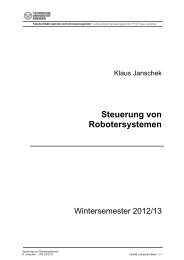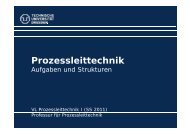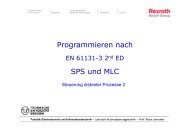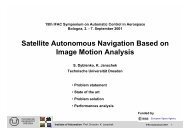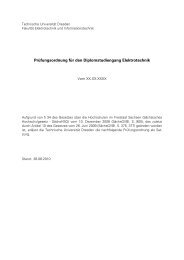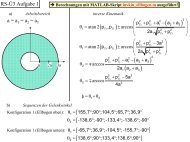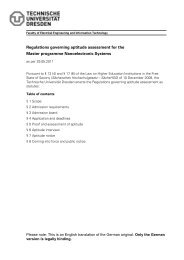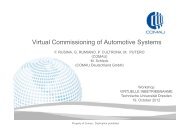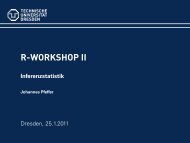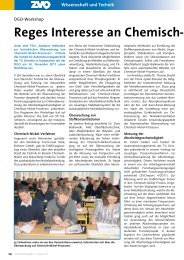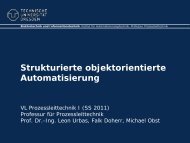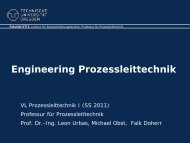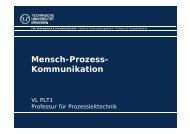the advanced concept of small satellite integrated navigation system ...
the advanced concept of small satellite integrated navigation system ...
the advanced concept of small satellite integrated navigation system ...
You also want an ePaper? Increase the reach of your titles
YUMPU automatically turns print PDFs into web optimized ePapers that Google loves.
Accuracy <strong>of</strong> Navigation and Attitude Determination<br />
Provided by Auxiliary Sensors<br />
The study has also demonstrated <strong>the</strong> efficiency <strong>of</strong> <strong>the</strong><br />
suggested landmark <strong>navigation</strong> technique: <strong>the</strong><br />
estimation process converges in a very wide scope <strong>of</strong><br />
orbits, camera characteristics, and o<strong>the</strong>r parameters <strong>of</strong><br />
<strong>the</strong> models. For <strong>the</strong> TUD-<strong>satellite</strong> reference mission <strong>the</strong><br />
method provides solution to <strong>the</strong> <strong>navigation</strong>al problem<br />
with maximum error not worse than 4 — 6<br />
kilometers 1,4 . The attitude is determined with <strong>the</strong><br />
maximum error not exceeding 1 degree (yaw) and 20<br />
arc sec (pitch, roll). So, <strong>the</strong> accuracy <strong>of</strong> orbit<br />
determination is much worse that accuracy <strong>of</strong><br />
GLONASS/GPS <strong>navigation</strong>, but <strong>the</strong> accuracy <strong>of</strong> attitude<br />
determination is comparable or even better; <strong>the</strong> latter<br />
fact can be effectively by information fusion.<br />
It is a well known fact that magnetometer <strong>navigation</strong><br />
provides accuracy <strong>of</strong> <strong>navigation</strong> with errors not<br />
exceeding 30-50 km and several degrees,<br />
correspondingly (see 9 and references in it); in o<strong>the</strong>r<br />
words, <strong>the</strong> accuracy is much worse that accuracy <strong>of</strong><br />
GLONASS/GPS or landmark <strong>navigation</strong>. At <strong>the</strong> same<br />
time, magnetometer can provide estimation <strong>of</strong> <strong>the</strong><br />
spacecraft space vector even when <strong>the</strong> initial estimation<br />
is very bad and at any moment <strong>of</strong> time. Hence, its data<br />
can be used for initialization <strong>of</strong> <strong>the</strong> <strong>navigation</strong>al <strong>system</strong><br />
and as a backup source <strong>of</strong> <strong>navigation</strong>al information.<br />
Conclusions<br />
This article shows that autonomous spacecraft<br />
<strong>navigation</strong> <strong>system</strong>, fitting minimal hardware <strong>concept</strong>,<br />
based on use <strong>of</strong> on-board GPS/GLONASS receiver,<br />
earth observation camera and magnetometer, is very<br />
prospective for LEO <strong>satellite</strong>s.<br />
The authors are going to continue <strong>the</strong> research in <strong>the</strong><br />
following main directions:<br />
• fur<strong>the</strong>r development <strong>of</strong> algorithms for attitude<br />
determination using <strong>the</strong> receiver and camera,<br />
• design <strong>of</strong> information fusion algorithms,<br />
• detailed performance evaluation considering<br />
enhances models <strong>of</strong> heterogeneous uncontrollable<br />
factors to obtain more justified numerical results.<br />
Acknowledgments<br />
The research is supported by INTAS Foundation<br />
(contract INTAS-96-2156, project «Autonomous<br />
<strong>navigation</strong> for low-earth orbit spacecraft using<br />
information fusion techniques»).<br />
The authors are grateful to Assis. Pr<strong>of</strong>. K. Sypalo<br />
(MAI) and graduate students I. Belousov, D. Kozorez<br />
(MAI) and T. Boge (TUD) for <strong>the</strong>ir invaluable help in<br />
<strong>the</strong> described research.<br />
References<br />
1. Jacobson, M. V. (1997). Autonomous Spacecraft<br />
Navigation Using Ground Landmarks. Proc. 6th<br />
Alumni Conference <strong>of</strong> <strong>the</strong> ISU, July 1997, Rice Univ.,<br />
Houston, TX, USA<br />
2. Janschek, K., et al. (1998). Minimum Hardware<br />
Concept for LEO Satellites Using Information Fusion.<br />
Proc. 12 th AIAA/USU Conf. On Small Satellites,<br />
Logan, UT.<br />
3. Krasilshikov, M. N., Dishel V. D. (1995).<br />
Methodology and Algorithms <strong>of</strong> Inertial System and<br />
External Data Composing Providing Preset Accuracy<br />
<strong>of</strong> Aerospace Vehicle Navigation. Proc. 1 st Brazilian<br />
Symp. in Inertial Eng. Nov 7 — 13, 1995, Sao-Jose dos<br />
Campos, S. P. Brazil Symp., pp. 1 — 12.<br />
4. Krasilshikov, M. N., Jacobson, M. V. (1995).<br />
Autonomous Spacecraft Navigation Using Ground<br />
Landmarks. Proc. 4th MAI/BUAA Intl. Symp. on<br />
Automatic Control. Moscow, Russia, August 28-30,<br />
1997. pp. 34-38.<br />
5. Krasilshikov, M. N., Jacobson, M. V., Kim, N. V.<br />
(1995). Development <strong>of</strong> Algorithms and S<strong>of</strong>tware for<br />
Autonomous Spacecraft Positioning System Based on<br />
Earth Observation. Proc. 46th IAF Congress. Oslo,<br />
Norway, October 2-6, 1995. Paper IAF-95-A.6.05<br />
6. Janschek, K., Boge, T., Krasilshikov, M., Dishel, V.,<br />
Jacobson, M., Minimum Hardware Concept for LEO<br />
Satellites Using Information Fusion. Proc. 12 th<br />
AIAA/USU Conf. On Small Satellites, Logan, UT,<br />
Sept. 1998. Paper SSC 98-IX-7.<br />
7. TUD-Satellite Phase A, Final Report, TU Dresden,<br />
Germany, April 1998.<br />
8. Spacecraft Attitude Determination and Control. Ed.<br />
by Wertz, J. R. Kluwer Academic Publishers, 1993.<br />
9. Wiegand, M. Autonomous Satellite Navigation via<br />
Kalman Filtering <strong>of</strong> Magnetometer Data. Acta<br />
Astronautica Vol. 38, No. 4-8, pp. 395 — 403, 1996.



